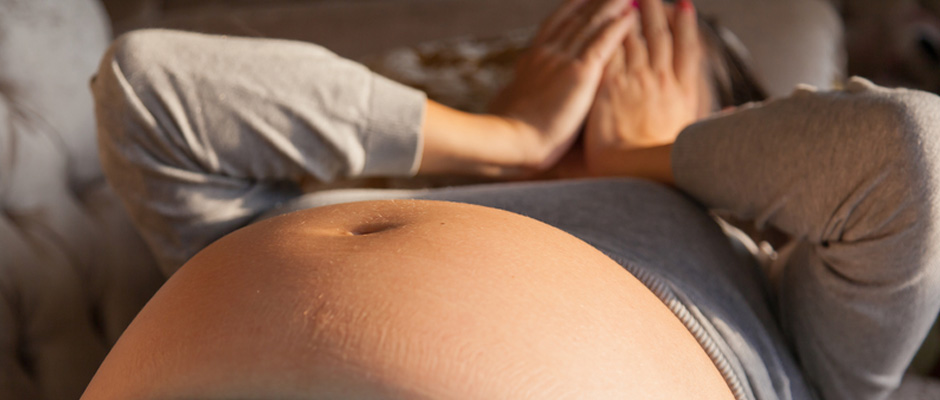
Being pregnant at 37 comes with its own bag of stress factors, including being labeled a "geriatric mother" à la Bridget Jones. But being pregnant at 37 with endometriosis takes the worry factor to skyscraper heights. I should be worrying about what theme I want to make my baby’s nursery or which baby shampoo is safest to use, but instead, I’m on a merry-go-ground of doctor’s appointments and fear that has left me Googling until the wee hours of the morning.
Before I could even consider trying to safely conceive, I had to endure countless painful tests and multiple surgeries to remove a uterine fibroid the size of a six-month-old fetus and a chocolate cyst that choked out my left ovary, which my doctor removed. I miraculously gave birth to my first son in 2014 at the age of 34. I was given a less than 13 percent chance of ever conceiving and IVF was never an option for me because the drugs I would’ve had to take were going to make my endometriosis spread like wildfire.
But after a lot of specialized care and prayer, I beat the odds and delivered a healthy 8-pound, 9-ounce bundle of joy.
Three years later, I was overjoyed to become pregnant again, but with much more concern this time about complications due to my age and a more advanced case of endometriosis. Every time I peed, I was terrified I was going to see blood. On Dec. 15, my worst nightmare came true. I got my son dressed to take photos with Santa at our local mall. I decided to hit the bathroom one more time before heading out, and when I reached down to wipe myself, a meteor shower of bright red blood and large clots washed over my hand. I immediately burst into tears and felt completely paralyzed. I was eight weeks pregnant at the time and still very much in the danger zone for miscarriage. I had recently remembered reading an article, which said women with endometriosis are 76 percent more likely to have a miscarriage than women without the condition. Knowing the facts, I felt like hope was literally going down the toilet.
I gently placed the largest clot, which was about the size of a 5-ounce steak, on a tissue near my sink, and wondered: “Is this my baby?” It was the worst feeling I had ever felt. I was helpless—frozen on my toilet convinced my miracle had just disappeared. My fingers cramped up as I attempted to dial my husband, who was still at work, and my aunt Maryann, who I was planning to pick up on my way to the mall. I could hardly speak. “I think I’m having a miscarriage,” I wailed into the phone.
My aunt told me not to move and that she was on her way. My granny came to watch my 3-year-old son as Maryann picked me up and drove me to the ER. As I walked in, with blood pouring down between my legs, I tried with every cell in my body not to let any more of that blood spill out. A nurse immediately got me a wheelchair once he realized the condition I was in.
I was quickly taken to a bed, administered an IV and assured a doctor was coming to check on me. As I lay there, I sobbed thinking of all the maternity clothes I had just ordered from Old Navy and how I didn’t want to even open the packages if I was, in fact, having a miscarriage. My heart remained optimistic while my mind took me to a dark place where I was contemplating if I should start planning my baby’s funeral. I didn’t even know if it was a girl or boy yet, but this child already had my heart. If need be, in that instant, I would’ve traded my life. I cried, I cursed, and I prayed silently in my head as I waited for answers.
After about 40 minutes, which seemed like an eternity, I was rolled into a sonogram room where the sonogram tech was stoic and harder to read than a Calculus book. “What’s happening?” I pleaded.
“Is my baby still alive? Can you see my baby?”
She urged me to calm down and told me she wasn’t allowed to tell me anything until the doctor came in. “Please, I am begging you to tell me something. I feel broken. Is my baby alive?”
And then, she showed me his beautiful little body with his arms and legs perched in battle mode. The child seriously appeared to be posed in the stance of the Fighting Irish leprechaun from Notre Dame. An ocean of relief washed over me. I was too thankful to speak. I just let out a big cry of gratitude.
When the ER doctor met with me and examined me, he determined it was likely a hematoma. His prognosis was very matter-of-fact. “It’s either going to be ok, or it’s not,” he said. “Let’s stay positive and hope for the best.”
I was then handed a bunch of papers with the terminology “Threatened Abortion” on them. My pregnancy was now like a dangling treasure almost out of reach and balancing off a cliff. It was hard to stay calm and take it easy, but in the following weeks, I had no choice but to do just that. I was placed on pelvic rest and had to refrain from exercise, sex and other activities I normally did.
I am now five months pregnant with my little boy who I have lovingly nicknamed “The Fighting Irish” because he is a fighter just like I am. I am still high risk and routinely visit a perinatologist now in addition to constant visits to my OB-GYN. Endometriosis has caused my pregnancy to be a rollercoaster ride, including causing false positives on tests and causing me more pain than if I didn’t have the disease. I’ve also been warned: antepartum bleeding tends to be more common among women with endometriosis. But my baby and I are survivors, and while I’m not out of the woods just yet, I’m not out of hope and strength, either.
We’re in this together.









